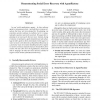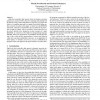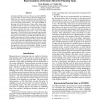208 search results - page 32 / 42 » How can a robot have consciousness |
JETAI
2002
13 years 7 months ago
2002
We study decision-theoretic planning or reinforcement learning in the presence of traps such as steep slopes for outdoor robots or staircases for indoor robots. In this case, achi...
ATAL
2004
Springer
14 years 29 days ago
2004
Springer
In real world applications, agents - be they software agents or autonomous robots - inevitably face erroneous situations that have not been planned for. Re-planning can sometimes ...
KI
2001
Springer
14 years 6 hour ago
2001
Springer
High-level controllers that operate robots in dynamic, uncertain domains are concerned with at least two reasoning tasks dealing with the effects of noisy sensors and effectors: T...
CCIA
2006
Springer
13 years 11 months ago
2006
Springer
: This paper presents a method called "Situation Matching" that aids to improve cooperative tasks in heterogeneous multi-agent systems. The situation matching (SM) above ...
AIPS
2000
13 years 9 months ago
2000
Goal-directed Markov Decision Process models (GDMDPs) are good models for many decision-theoretic planning tasks. They have been used in conjunction with two different reward stru...



